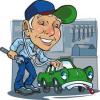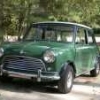As you are finding out, Minis in North America are often a potpourri of parts. While there was a standard configuration for your Canadian spec '74 as delivered, it may not be that same configuration today. So... I'll post some links for you to review and determine what is on your car.
See the linked page below to 7-Ent.
http://www.7ent.com/...nts-pg-131.html
The inboard ends of the driveshafts are shown on the "right" side of the linked page..
The driveshafts shown as items 1 & 2 are the yoke-type used in the early 1960s. They use either a rubber cross or plastic cup u-joint assembly shown as item 7. If you see something similar to item 6 on the inboard end of your driveshafts... you have the early yoke-type shafts.
Later in the early car production they switched to the Hardy-Spicer joints. Those are u-joint assemblies with flanges they look like items 3, 4 & 9.
Later cars (up to the end of production) used "pot joints". Those are basically inboard CV joints. See item 15 on the page. They are very different in appearance to the early driveshafts. It will be obvious to you if that is what you have.
Gearboxes... there are three main configurations: Magic Wand, Remote, and Rod. For a general overview, see the page from 7-Ent linked below.
http://www.7ent.com/...n-id-pg-49.html
The magic wand shifter comes through the floor near the firewall. The remote and rod shift boxes have the gearshift coming up from the floor between the front of the seats. Therefore it is easy to determine if you have a magic wand. To determine if you have a remote or rod shift box is easily determined by poking your head underneath the car. The remote shift gearbox has a long skinny aluminum housing going from the gearbox back to under the shift lever. The rod shift box has exposed steel rods instead.
By year, your car should probably have the rod change gearbox. But it could have a transplant from another car so it is always best to look.
















